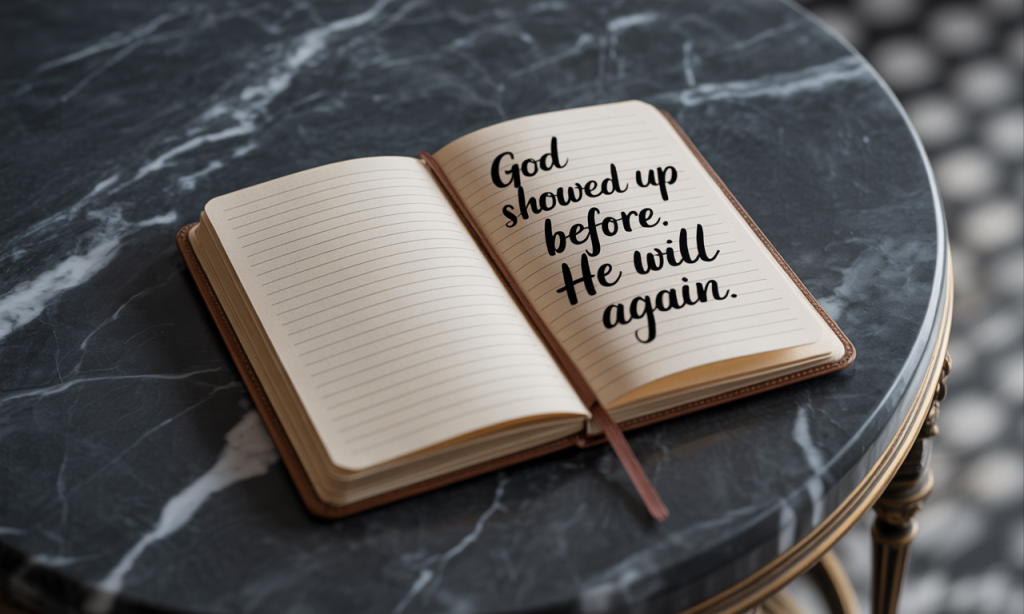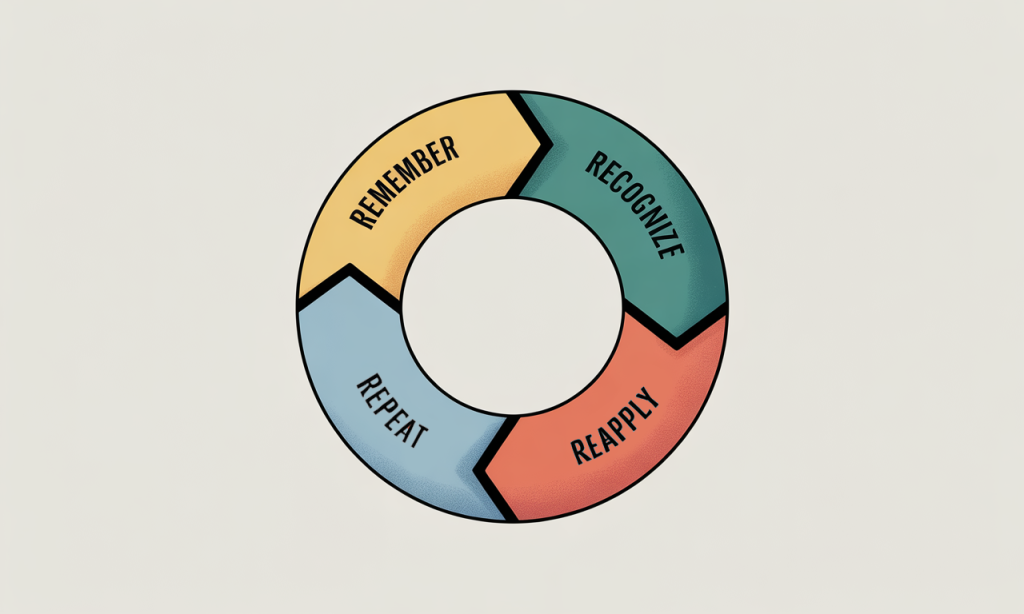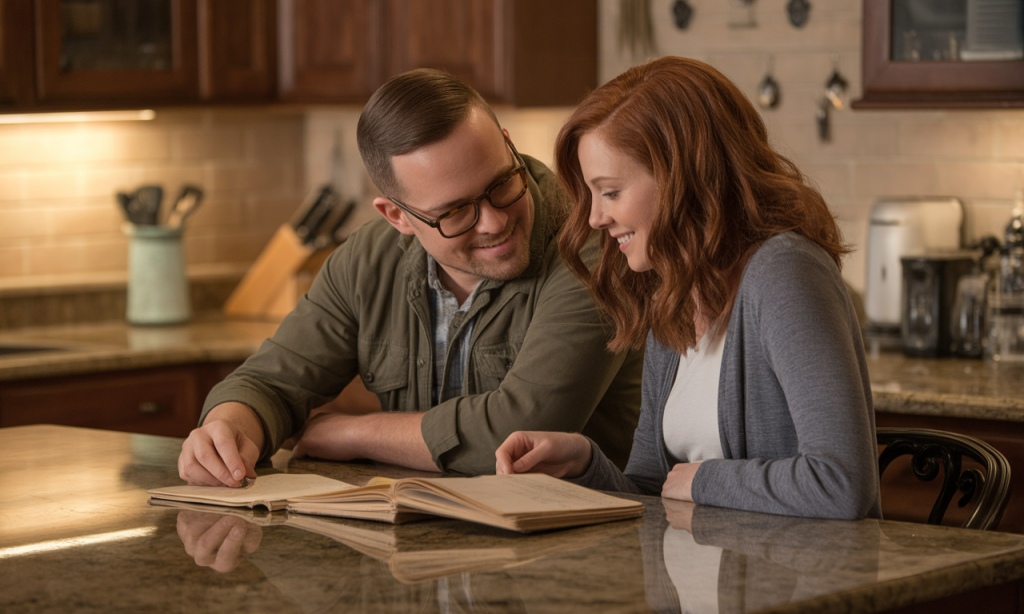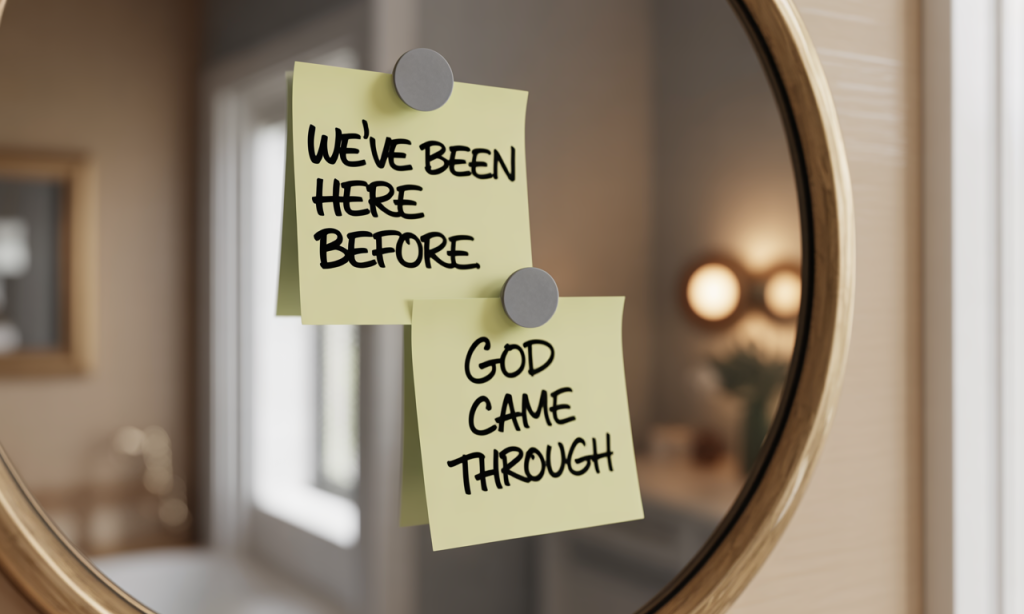The Hope Loop: How Remembering Yesterday Fuels Tomorrow

Hope isn’t built from prediction—it’s built from pattern. When life feels uncertain, imagining a better tomorrow can feel hollow, but remembering how God has shown up before changes everything. The Hope Loop helps you notice the repeat evidence that love and grace have always returned, even after silence. By tracing answered prayers, repaired connections, and laughter that reappeared after conflict, you’ll learn to see your marriage not as a series of isolated events but as a loop—proof that light keeps finding you. This isn’t blind optimism; it’s a grounded confidence built on the data of your own shared story.
Why Hope Isn’t Prediction—It’s Pattern
 When people lose hope, it’s rarely because of what’s happening right now. It’s because they’ve forgotten the patterns that prove change is possible. Hope doesn’t grow from guessing the future—it grows from remembering how often love and grace have returned before.
When people lose hope, it’s rarely because of what’s happening right now. It’s because they’ve forgotten the patterns that prove change is possible. Hope doesn’t grow from guessing the future—it grows from remembering how often love and grace have returned before.
Every couple has these rhythms: the time you thought the argument was the end, but it wasn’t. The season when finances felt impossible, but provision came. The stretch when you couldn’t feel close, yet laughter still found its way back.
Hope is pattern recognition. It’s realizing that the same God who helped you then is still in the room now.
This truth echoes the cornerstone post When You Can’t See a Way Forward: How Looking Back Rebuilds Hope—which teaches that reflection isn’t retreat; it’s strategy. The Hope Loop takes that one step further by showing you how to turn reflection into momentum.
What the Hope Loop Is (and Why It Works)
 The Hope Loop is a spiritual practice of recalling the cycles of goodness that keep repeating—so you stop treating every setback like the first one. It’s noticing, naming, and looping back to evidence of grace until faith becomes muscle memory.
The Hope Loop is a spiritual practice of recalling the cycles of goodness that keep repeating—so you stop treating every setback like the first one. It’s noticing, naming, and looping back to evidence of grace until faith becomes muscle memory.
Here’s the pattern:
Remember → Recognize → Reapply → Repeat
- Remember how God has carried you before.
- Recognize similar patterns of help showing up now.
- Reapply faith by responding with gratitude instead of panic.
- Repeat the process when the next uncertainty arrives.
Over time, this cycle turns despair into data. Your hope stops being theoretical—it becomes measurable.
This concept aligns with The Evidence File: Building Proof That Love Still Lives Here. Both are about building emotional and spiritual case files that remind your heart that grace has a track record.
Step One: Remember Where Hope Has Shown Up Before
 Start your Hope Loop by recalling specific instances when hope seemed gone—but wasn’t.
Start your Hope Loop by recalling specific instances when hope seemed gone—but wasn’t.
Ask yourselves:
- What was a time we thought something was over but it wasn’t?
- When did peace return after we stopped trying to control everything?
- Where did we see God’s fingerprints only in hindsight?
These answers are the raw materials of your Hope Loop. You’re not rewriting the past; you’re mining it for proof.
Write them down. Speak them out loud. Even if the memory feels small—like the night you laughed after a tense day—it counts.
That moment was your marriage remembering how to breathe.
If you’ve already created The Memory Bank: Saving Good Moments for the Days You Forget, review it through this lens. Every “deposit” is a receipt of God’s reliability.
Step Two: Recognize the Recurring Rhythms
 Every couple has recurring grace rhythms—patterns of healing, laughter, timing, or peace that return like seasons. Once you spot them, you’ll realize they were never coincidences; they were consistency disguised as chance.
Every couple has recurring grace rhythms—patterns of healing, laughter, timing, or peace that return like seasons. Once you spot them, you’ll realize they were never coincidences; they were consistency disguised as chance.
Look for these categories:
- Emotional Patterns: How calm returns after chaos.
- Spiritual Patterns: How prayer or Scripture brings clarity.
- Relational Patterns: How repair happens even after tension.
The Hope Loop works because it turns vague memories into concrete evidence. You stop saying “maybe it’ll get better someday” and start saying “it’s gotten better before, and this looks like the beginning of that again.”
This mindset pairs naturally with Proof of Life: Finding What’s Still Working When Everything Feels Off—where couples learn to spot subtle signs of love in the middle of difficulty. Together, they form a twin practice of recognizing what’s alive instead of rehearsing what’s wrong.
Step Three: Reapply Faith Through Gratitude
 Once you see the pattern, the next step is response. Gratitude reactivates the circuit. It tells your nervous system, “We’re safe; we’ve seen this ending before—and it was good.”
Once you see the pattern, the next step is response. Gratitude reactivates the circuit. It tells your nervous system, “We’re safe; we’ve seen this ending before—and it was good.”
When you notice old evidence resurfacing (like calm after tension or unity after prayer), say it aloud:
“This feels familiar. We’ve been carried like this before.”
Speaking faith aloud isn’t forced positivity—it’s pattern awareness. Gratitude turns remembrance into momentum.
This step mirrors the posture described in Celebrate the Ordinary: How Noticing Small Joys Changes the Mood of Your Home. Both use micro-gratitude as a tool to reset emotional tone. The Hope Loop just roots it deeper in faith history.
Step Four: Repeat the Loop Until Hope Feels Automatic
 Hope strengthens through repetition. The more you cycle through remembering, recognizing, and reapplying, the less fragile it feels.
Hope strengthens through repetition. The more you cycle through remembering, recognizing, and reapplying, the less fragile it feels.
Soon, you won’t need to force perspective—you’ll have built it. Your reflex will shift from “What if this goes wrong?” to “We’ve been through worse—and came out stronger.”
This is the miracle of the Hope Loop: it doesn’t erase hardship; it reframes it as the middle of a familiar story.
You can reinforce this mindset by creating a visual cue—a note on your wall that reads, “We’ve seen this before.” Pair it with Anchor Objects: Little Things That Trigger Big Love for tangible reminders of recurring faithfulness.
Step Five: Spot God’s Signature Across the Seasons
 When you step back, the Hope Loop reveals God’s signature written across your timeline. He’s been showing up with the same character—steady, creative, precise—no matter the circumstances.
When you step back, the Hope Loop reveals God’s signature written across your timeline. He’s been showing up with the same character—steady, creative, precise—no matter the circumstances.
Take time to trace His consistency:
- How did He use old wounds to produce new wisdom?
- How did He turn delays into preparation?
- How did He pair His timing with your readiness?
You’ll begin to see that your story isn’t random—it’s rhythmic.
This recognition turns prayer from pleading to partnership. Instead of asking, “Will You?” you begin saying, “You always have.”
That’s the language of mature hope.
If you want to take this reflection deeper, explore Faithful Remembering: Spiritual Practices to Recall God’s Goodness in Marriage. Together, these practices become a lifestyle of noticing divine patterns and responding with worship.
Step Six: Use the Hope Loop in Real Time
 When new challenges appear—tight finances, emotional distance, or uncertainty about the future—activate your Hope Loop:
When new challenges appear—tight finances, emotional distance, or uncertainty about the future—activate your Hope Loop:
- Pause.
- Ask, “When have we felt this way before?”
- Recall what eventually shifted.
- Speak gratitude before panic has a chance to speak fear.
You’ll find that your faith doesn’t disappear during hardship—it just forgets where it last saw the evidence. The Hope Loop helps you relocate it fast.
Pair this step with The Five-Minute Rewind: A Micro-Practice for Hard Days to create a quick emotional reset when tension rises.
Step Seven: Teach Each Other How to Spot the Loop
 One of the best ways to strengthen your marriage is to become witnesses of each other’s faith. When your spouse starts to spiral, you can say, “This looks familiar—remember how it ended last time?”
One of the best ways to strengthen your marriage is to become witnesses of each other’s faith. When your spouse starts to spiral, you can say, “This looks familiar—remember how it ended last time?”
You’re not minimizing their pain—you’re pointing to proof. The Hope Loop works best when practiced together. It’s a shared language for recognizing God’s fingerprints.
Here’s a quick couple’s cue:
- When one person says, “This feels hopeless,”
- The other responds, “What did we learn the last time it felt like this?”
That small question reopens the loop.
If you’ve been doing Past Grace, Present Strength: How to Borrow Faith from What You’ve Survived, this step will feel natural. Both are about gathering evidence that what’s been true before will be true again.
Step Eight: Let the Hope Loop Become Your Testimony
 Once you’ve lived through a few cycles of remembering and renewal, your testimony changes. You stop saying, “We hope God shows up,” and start saying, “He always does.”
Once you’ve lived through a few cycles of remembering and renewal, your testimony changes. You stop saying, “We hope God shows up,” and start saying, “He always does.”
That statement isn’t arrogance—it’s evidence. It’s the result of years of documented faithfulness.
You can even share your Hope Loop story with other couples who are struggling. Testimony transforms remembrance into ministry.
If you’re ready for that stage, visit Remembered on Purpose: How Couples Can Reclaim Joy Through Shared Testimony for practical ways to turn your story into encouragement for others.
Step Nine: Keep the Loop Open
 The Hope Loop never ends—it grows. Every time you walk through a storm, you add another turn to the spiral of faith.
The Hope Loop never ends—it grows. Every time you walk through a storm, you add another turn to the spiral of faith.
One day, when another couple feels hopeless, you’ll be able to say, “We’ve seen this pattern too. It always ends with peace.”
That’s the power of hope rooted in history—it multiplies.
So today, ask yourselves:
“What are the three patterns of grace that keep showing up in our story?”
Write them down. Speak them often. Because those patterns are the map you’ll follow when tomorrow feels dark.
The loop isn’t a theory—it’s your proof.


